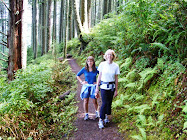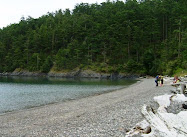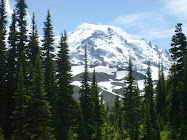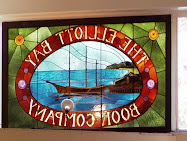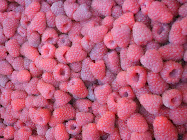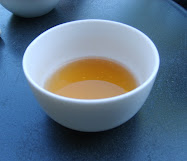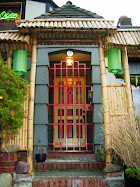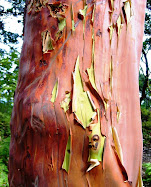 |
| Mt. Baker looms in the distance over LaConner and the Swinomish Channel. |
On a brilliant late April morning, I make a snap decision to hop in the Subie and drive the 70+ miles (about an hour) north from Seattle to catch the last of the tulip fields in bloom. We "coasters" here in the Pacific Northwest have to seize our sunny days when we can this time of year.
What ensues is a bit of a mad dash up and back, with several quick stops. I leave north Seattle at 9 am and am back by 2 pm. Doable, got my dose of Skagit love, but I suggest a more leisurely trip. In the meantime, come on a quick tour with me via this blog.
Snow Goose Produce: Besides the tulips and sunshine, it's the spot prawns that draw me north today. Coming from Seattle, I get off I-5 at Conway, the first exit after descending to the Skagit River Flats, and meander west past small farms and fields being prepped for the growing season ahead. A mile or two after the road turns a right angle north, Snow Goose is on the left, but their advance signs shout at you (Spot Prawns! Ice Cream Cones! Farm Fresh Produce!).
 |
| San Juan Islands spot prawns available at Snow Goose Produce |
The friendly and knowledgeable folks there sell local fresh seafood (today it's fresh halibut and spot prawns), lots of produce and plant starts, fresh pasta, some yard furniture and gift items, and more. Snow Goose is also famous for their generous ice cream cones from local makers like Lopez Island Creamery. I indulge in a kid's size scoop of maple walnut, which is plenty.
LaConner/Snee-Oosh Beach: Scenic historic town turned tourist destination LaConner deserves a whole blog post, but today I blow through on my way to Snee-Oosh Beach on Upper Skagit Bay. I stop just across the Rainbow Bridge to take a few shots (the top photo above and below) before passing through the Swinomish Indian Tribal Community enroute to the beach.
 |
| Looking south at the Swinomish Channel from the Rainbow Bridge |
This morning is a pretty low tide, which makes life difficult for the guys trying to unload and carry their canoe back up beach in the grabby tideflat muck. They tell me they camped on Hope Island last night and awoke to the lyrical sound of loons crying across the open water.
 | |
| At low tides (like today), you can't paddle around Dead Man's Island in Skagit Bay. |
 |
| The Olympic Mountains beyond Whidbey Island to the west. |
 |
| These guys were not happy campers in the muck. Hope Island is in the background. |
Tulip Fields Forever: Well, not forever, since I'm catching the tail end of the tulip festival this year. But the fields on the now-famous tulip route seem to go on forever in big patchwork rows of bold colors. While I'd hoped to avoid the crowds on a week day, which was possible back in the 1990s and earlier, not so easy now. It's just me and busloads and carloads of tourists.
These days the bigger farms like Roozengaarde's charge $5 to park at their farms. Really the way to go is on a bicycle (bonus is how flat the Skagit Flats are and easy to negotiate on a bicycle).
Christenson's Nursery: It's only fitting that this abundant land of farms has a spectacular destination nursery. I stop at Christenson's for inspiration and a quick stroll through. They have multiple large greenhouses crammed full of just about any plant you can think of, from succulents to moisture-loving ferns and flowers, to trees and shrubs. For all those wonderful plants there are also lots of pots and garden ornaments too.
Then I zip back into LaConner for a quick lunch. The restaurant I choose is, sad to say, not blogworthy. But I've had good chow before at the LaConner Brewery Brewpub and the Calico Cupboard Cafe, which is very popular with the older folks.
Before I'm ready, it's time to return to Seattle for a mid-afternoon appointment. Bonus is that I beat Friday rush hour traffic. Bad news, not enough time in the Skagit!
What are your favorite places to go and things to do in the Skagit?
When You Go
The annual Skagit Tulip Festival continues through the month of April, so there's still time to catch a bit of the color. It's also a great time to go birding and kayaking around Skagit Bay, many locations but start at the Skagit Wildlife Refuge managed by the Washington Department of Fish and Game near Conway. A bit later in the spring more of the farm stands open, like Hedlin's Family Farm just outside LaConner and Pheasant Ridge Farm.
























.jpg)

.jpg)


.jpg)




















